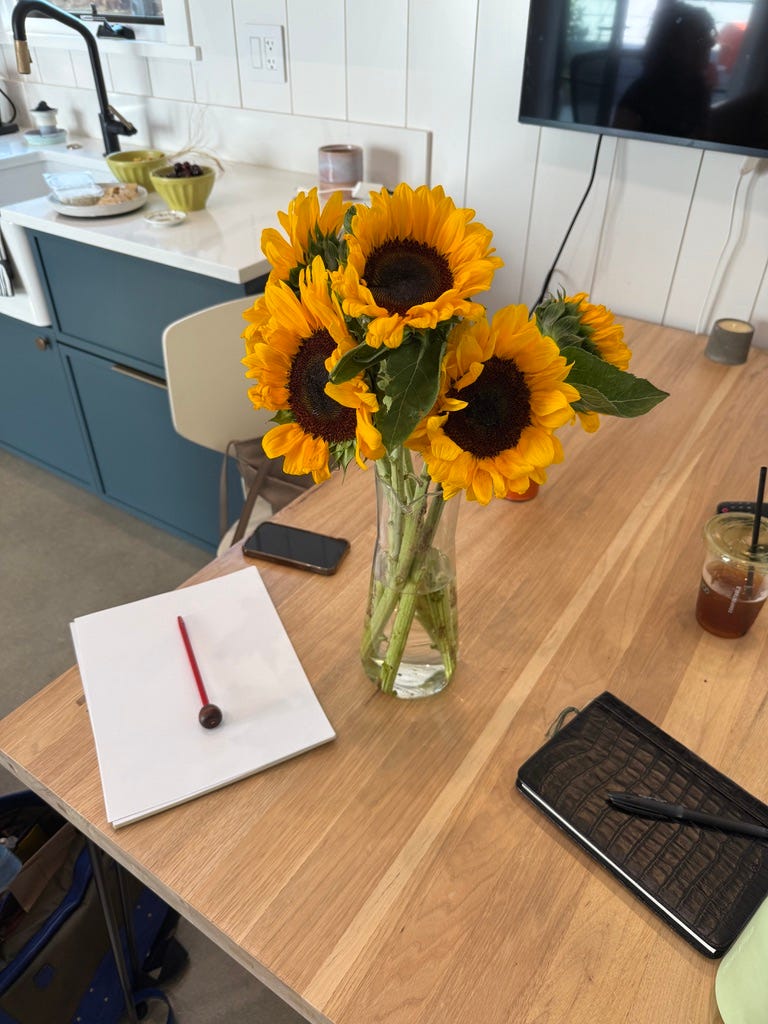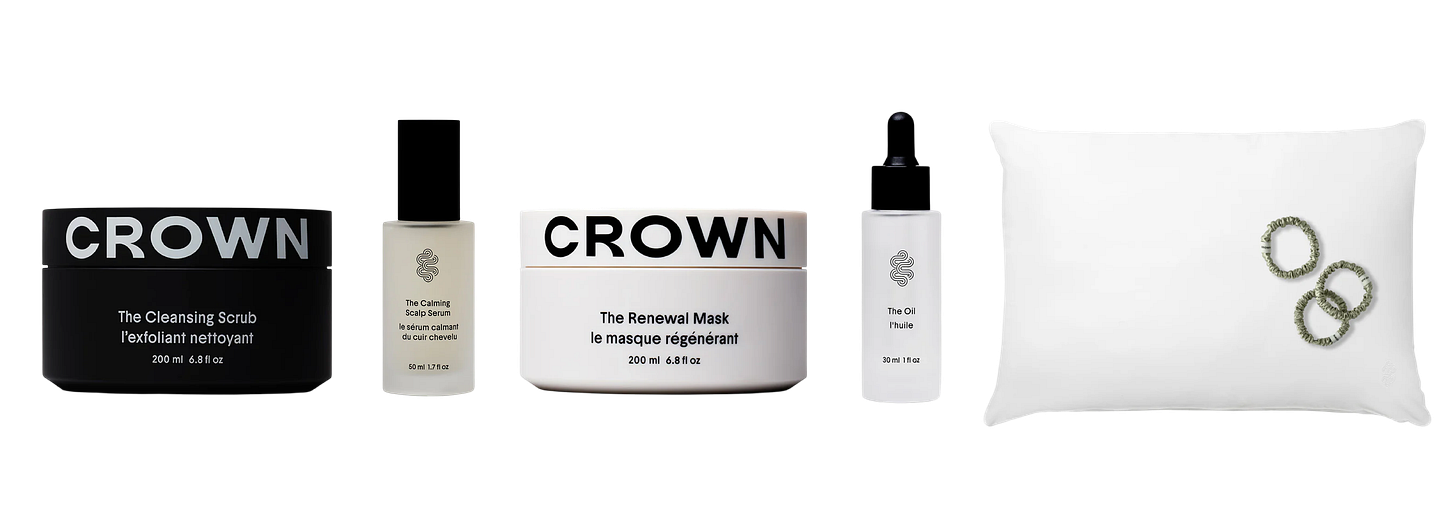The Nervous System Reset That Changed My Life
How I finally broke old patterns through Brainspotting
Welcome back to Take Your Time — a space where I share pieces of my world in the hope that they spark growth, reflection, and connection for all of us. Today’s letter may be the most vulnerable I’ve written yet, but I’ve learned that sharing the real conversations is what makes this community meaningful. So here it goes.

Two years ago, Elaine (our CEO at Crown Affair) and I started working with an executive coach named Dr. Faith Cohen, PhD (no relation — though many of the most important people in my life happen to be Cohens). Since then, she’s taken us on a challenging, beautiful, and transformative journey to become the best leaders and people we can be for our team and for each other.
Working with Faith alongside Elaine has opened space for real growth — personal expansion, energetic release, learning to trust, and discovering what it means to live from abundance. Most of this executive coaching work has been done through talking, which is powerful and clarifying. You have breakthroughs, and sometimes they stick — but often they don’t clear and heal the deeper patterns, because talk alone doesn’t access the limbic brain (more on that below). And I knew I needed more than talking things through in my temporal lobe — I needed a full rewiring of my nervous system.
Before we get into Brainspotting, why I did it, and how it changed my life, we need to admit a real truth: starting a business requires a little bit (okay, a lot) of delusion.
I joke about it (cue the Legally Blonde line: “Happy people just don’t shoot their husbands!”), but really, people who are perfectly happy just don’t start companies! Or maybe some do, but to sustain it, you often have to be proving something — to yourself, to others. Many of my closest friends, and even my husband (aka Bubs), don’t have that entrepreneurial itch. And I think it’s because they deeply, authentically love themselves. Not just surface-level confidence, but real self-assurance and safety in who they are. They don’t feel a compulsion to start something to prove their worth; they already know they’re worthy.
For me, part of my drive has always been wanting to be more than I thought I was. A lot of it comes from my dad, who loves me endlessly, but has lived his life through fear and scarcity (can you blame him? The Jewish side of my family carries deep generational trauma). On one hand, it’s a gift. He did his best — he kept me sharp, always a few steps ahead, instilling the belief that everything — except your mind — can be taken away in an instant. That mindset, that ambition, got me here. But, as I’ve gotten older, and as Crown Affair has matured, I’ve realized: it won’t get me where I need to go.
I’m not burnt out. But, my nervous system? Shot.
I was at a point where seeing something on Instagram at the wrong moment could send me spiraling into a shame loop about not being enough.
And, here’s the paradox: logically, I know I’m doing great. We’ve built something from the ground up. I’ve been with the love of my life since 2013, my family and friends are healthy, I travel, I create — a lot of the boxes are checked. And still, that deep wiring wasn’t working anymore. I knew the what of my issues (we’d talked and talked about them).
What I needed was a subconscious nervous system reset.
Enter: Brainspotting.

So, What Exactly Is Brainspotting?
Brainspotting is a therapeutic method developed by David Grand, PhD, in the early 2000s. It’s considered a brain–body therapy because it works directly with the nervous system as well as the mind to process trauma, stress, and emotional blocks that often live below conscious thought.
The basics:
The core idea is simple: where you look affects how you feel.
During a session, a therapist helps you find “brainspots” — specific eye positions linked to unprocessed memories, emotions, or body sensations. Sometimes it’s discovered by following your gaze with a pointer; other times it’s noticing subtle reflexes like a blink, a twitch, or a change in breath.
Once the spot is located, you hold your gaze there while allowing whatever comes up — body sensations, emotions, thoughts — to surface.
Staying with that point helps the brain and body process what’s been stuck, often bypassing the rational, storytelling part of the brain and accessing deeper layers of healing.
What it’s used for:
Brainspotting is used to treat trauma (both acute PTSD and long-term developmental trauma), anxiety, depression, and performance anxiety. It’s also been used for creative or athletic blocks, and even chronic pain where emotional patterns play a role.
What it feels like:
Sessions are quiet, surprisingly gentle, and deeply internal. Unlike traditional talk therapy, you’re not asked to relive or retell the painful story over and over — instead, you stay present with your body’s felt sense. Many people describe it as accessing something “beneath words,” and shifts often happen more quickly than with talk therapy alone.
Compared to EMDR:
Brainspotting is often compared to EMDR (Eye Movement Desensitization and Reprocessing) since both use eye positions to access the brain. But Brainspotting is less rigid and more client-led. EMDR follows a structured protocol of bilateral stimulation, while Brainspotting allows the body to guide the process in a more organic, intuitive way. Many therapists actually integrate both.
What’s happening to your brain during a Brainspotting session, explained by Faith directly (I paraphrased for clarity):
You can’t access the limbic brain — the amygdala or hippocampus — through talking. When we talk, we’re primarily activating the temporal lobe, where our language centers live. To truly access the mid-brain, the deep limbic system where trauma is stored, you need something different.
This is where bilateral stimulation comes in. It’s the hallmark of trauma-release techniques. Through sound or movement, you’re stimulating both sides of the body and sending signals across the corpus callosum — the bridge between the brain’s hemispheres. This keeps the frontal lobe online.
For our session, I listened to this bilateral sound healing playlist the entire time gently in the background.
Why does that matter? When the amygdala fires, it shuts off the frontal cortex to respond to danger. That’s useful if you’re being chased by a saber-tooth tiger — you don’t want to analyze, you just want to run. But in daily life, when old triggers send us into fight-or-flight, the shutdown isn’t helpful. Bilateral stimulation allows the frontal cortex to stay engaged while you process what’s stored in the limbic system.
And here’s the powerful part: once a trigger is cleared, it’s cleared. In talk therapy, you may understand your patterns but still find yourself repeating them — because the limbic system hasn’t been accessed. In Brainspotting, you’re literally rewiring.
The neurons in your limbic system are making new connections to your frontal cortex. By changing the way a memory is processed, the protein structure of that memory shifts — that’s neuroplasticity.
Our brains are incredibly bendy — capable of rewiring in both positive and negative directions. Once you’ve processed and released, the memory remains, but it no longer activates you. Your body doesn’t respond as if it’s dangerous anymore.
That’s the impact: you’re not just understanding the story. You’re rewiring the system.

At the end of July, I flew to Boulder for a 2-day intensive with Faith, who was one of the first to train directly under Dr. David Grand, and someone incredibly intuitive in her executive coaching work with founders and CEOs. In simplified terms, we mapped my life visually: the places where I feel safe, the places where I feel love. Then we built an “elevator” of my triggers — each floor a different spiral I tend to ride down — and she gave me the tools to step off before the drop.
Because she knows me so well, she also wove in practices like nature bathing and intentional time outdoors. As a deeply visual person, having those physical anchors was essential for mapping and connecting the brain spots.
In the most magical way— I haven’t been the same since. Ask Elaine, ask Bubs, ask my friends — I’m still me, but lighter. My energy is back. I feel authentically abundant. I don’t punish myself for not being enough or not having enough. And if something does trigger me, I now have the tools to move through it. My code is different.
After years of talking about what I want to shift, this specific modality has been the key to real change for me. I’m forever grateful to Faith — for how she’s supported me, for how she’s supported Elaine, and for how profoundly she’s shaped my life. That’s the thing about entrepreneurship: it’s never just a business journey. It’s equally the personal journey you’re called to walk.
Crown Affair has been the vehicle for so much growth and abundance in my life. It’s been insanely challenging and also the most fun I’ve ever had. If you’re starting a business, or thinking about it, know this: you’re not just building a company. You’re signing up to become a new human along the way. And for that, I’m endlessly grateful.
If you’re a founder or CEO and you feel stuck — or simply know you’re ready for a reset — reach out to Dr. Faith (drfaithcohen.com) or ask an executive coach or the therapist in your life if this might be a fit for you.
Take your time, and take care, always,
Dianna
And now…
Three Things I Love:
De la Heart Padel — I’ve been using this since early pandemic days, and it deserves another shout-out as the OG. Lymphatic drainage rituals are so important (I swear by daily gua sha for my face), and this is essentially that—but for the body.
The Row Jouve Bag — This bag turned out to be the most unexpected winner. Earlier this year, I popped into The Row’s LA store to treat myself to the black suede Margaux (we love), but truthfully, I use this sling bag a thousand times more. Part of me wishes I bought it in brown (get the brown), but the black is chic too. It was my hero bag for Japan and Copenhagen, and today I wore it to CVS and to pick up dry cleaning. It holds so much without ever feeling heavy—some Olsen sorcery, truly. From cameras to journals, it fits like a tote but drapes across your body. From a cost-per-wear perspective, worth every penny.
Comme Si x Coppola Hideaways — My girl Jenni keeps the hits coming, and this time with my forever It girl, Sofia Coppola. The Coppola Hideaways collab is perfection. I live in my pink set/pair and just picked up the green stripe—constantly on rotation.
A Haircare Tip: A Fall Reset for Your Hair
Just like our routines shift with the season, your hair benefits from a reset in the fall. Summer often leaves behind buildup—think sunscreen, salt water, sweat—that can weigh strands down. Fall is the perfect time to clear that slate and start fresh.
Clarify and cleanse — Begin with a gentle clarifying wash to remove buildup and give your scalp room to breathe.
Hydrate deeply — Cooler air can be drying, so add in a weekly mask like The Renewal Mask to restore softness and shine.
Tend to your scalp — A scalp treatment helps stimulate circulation and create the healthiest environment for new growth as we enter a new season.
Lean into ritual — Brushing before bed, massaging oil into your ends, swapping to a silk pillowcase—all small gestures that make a big difference over time.
Your hair is always changing with the seasons. Fall is about returning to center—nourishing, resetting, and creating a foundation for the months ahead.





I’m intrigued, tysm for sharing!
P.S. Deeply relate to having something to prove and an anxiety-inducing Jewish father
My favorite substack of yours yet! I did EMDR therapy after a car crash a few years ago and was so impressed with the results in just a few sessions. I’m so intrigued by this (7 years of build Ghia -> I need a lobotomy)